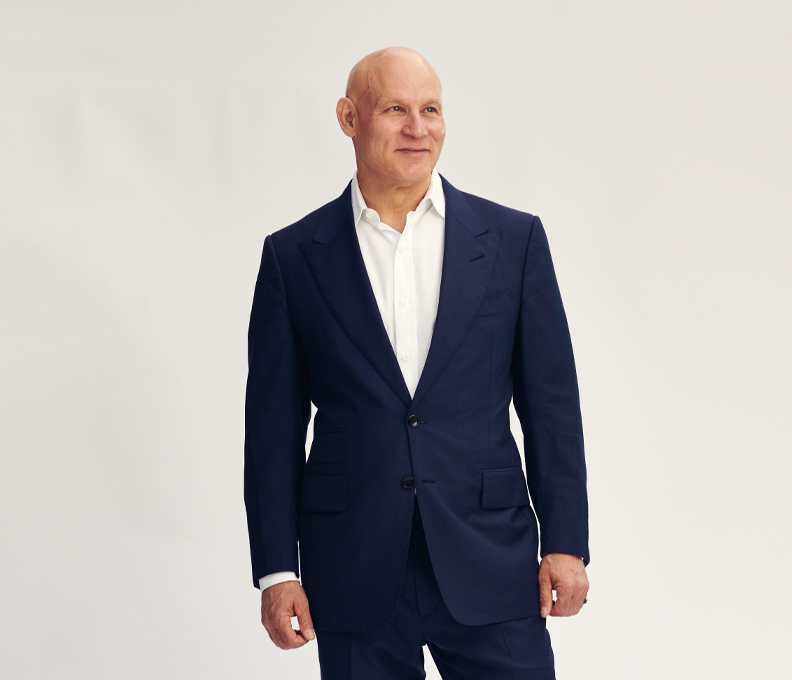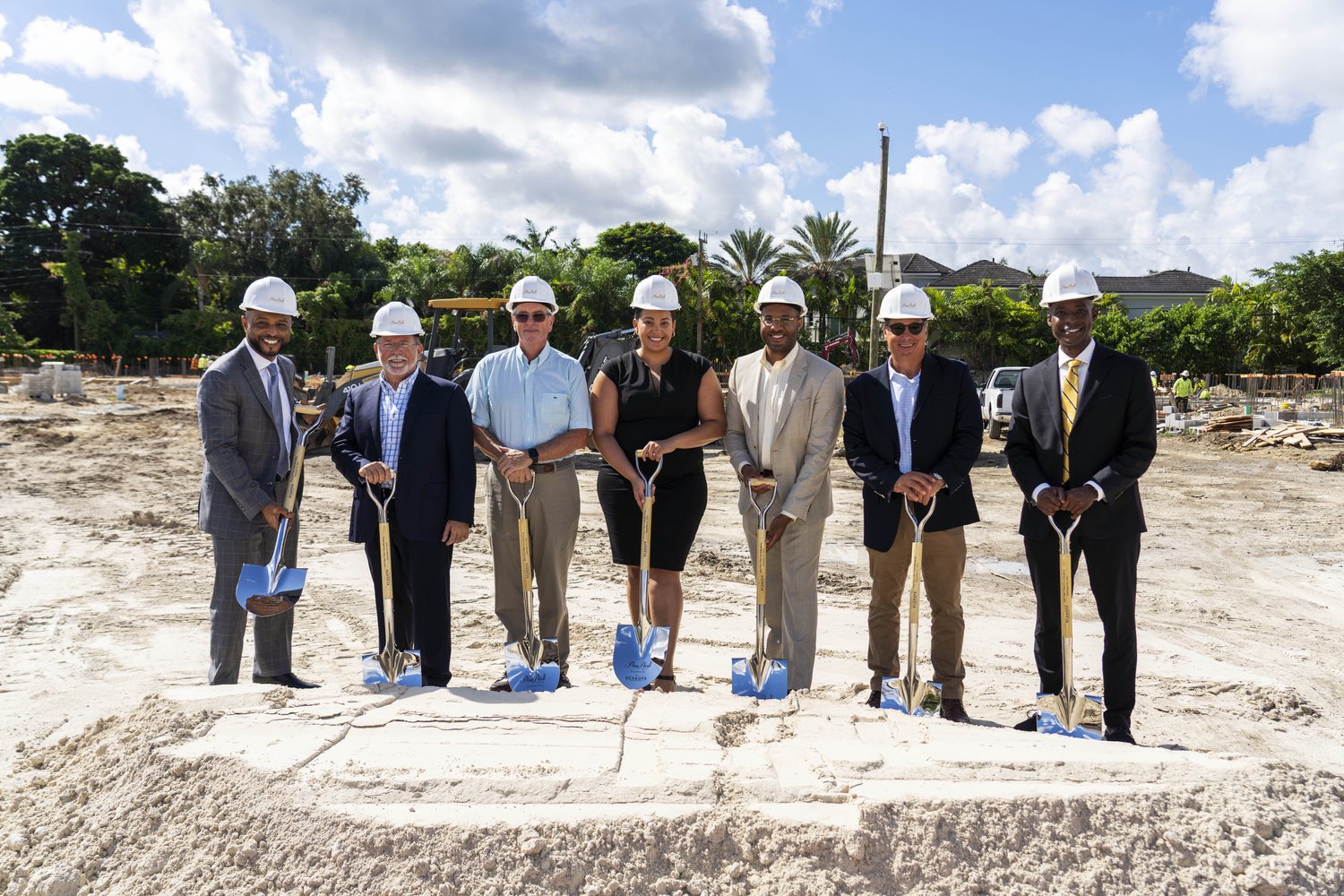How Craig Robins Transformed the Miami Design District
In the vibrant world of Miami’s business and cultural scene, few figures shine as brightly as Craig Robins. With a blend of visionary entrepreneurship, groundbreaking real-estate savvy and an unwavering passion for art and architecture, Robins has carved an indelible mark on the city with the Miami Design District, where luxury and commerce unite.
Daniel Toole’s Jade Alley and 41st Street shops / Photo: Courtesy of Ra-Haus
Spanning more than 18 city blocks, the Miami Design District is characterized by its modern architecture, flagship boutiques, high-end galleries and innovative dining. It’s where immersive installations by globally acclaimed art-world figures such as Es Devlin sit alongside the tastefully lacquered storefronts of Louis Vuitton and Gucci—all anchored by two public museums, the de la Cruz Collection and the Institute of Contemporary Art. The district has also emerged as a focus for sustainability, boasting the distinction of being the first project in the world to achieve LEED Gold Neighborhood Development certification.
“I wanted the Design District, which had some historical architecture, to become a place where there were more people,” says Robins. “We didn’t want to be mainstream because we never want to be mainstream. You always want to invent things.”
An Eye for the Unseen
From the beginning of his career, Robins was fueled by a drive to revitalize neglected neighborhoods in new, unexplored ways. Born and raised in Miami Beach, Robins has had a firsthand view of his hometown’s many metamorphoses. His father, Gerald, was a successful developer who introduced Robins to real estate—a field that, ironically, didn’t initially interest him. Time spent studying abroad at the University of Barcelona changed his perception by inspiring an appreciation of art, borne through the architecture and artworks he came across in the Spanish metropolis.
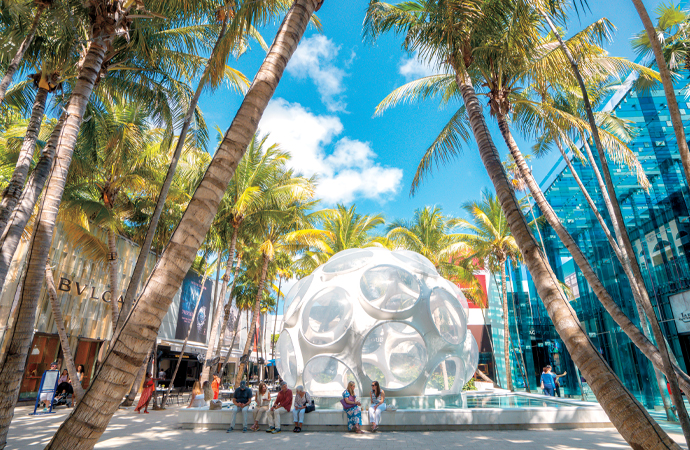
The Miami Design District’s Palm Court, featuring Buckminster Fuller’s Fly’s Eye Dome / Photo: Courtesy of Luis Gomez
“That’s when I really discovered art, and also a lot of architecture,” he says. “Gaudí, urban design. beautiful urban environments versus suburban places. I was very intrigued with that and, very modestly, because I didn’t have a lot of resources, I began to collect.”
Upon returning to Miami to attend law school, Robins used his free time to help artists find spaces to exhibit their work. This eventually led to a meeting that changed his trajectory, and ultimately the face of Miami. After being introduced by his father to New York real-estate developer Tony Goldman, who was then renovating a number of properties on a threadbare South Beach, Robins approached Goldman about buying a studio for one of his artists. In the end, he purchased half of two buildings along Fifth Street at Ocean Drive and Washington Avenue with a down payment of $20,000. Goldman—who pioneered the renovation of New York’s SoHo and, later, Miami’s Wynwood—became a mentor to Robins, and the two became instrumental in transforming Miami Beach’s architecturally significant Art Deco District.
“At the time, South Beach had this dwindling senior population who had come to Miami to retire,” says Robins. “There was nothing in South Beach. And I had these two properties. When I look back on it, I can’t believe it. My first tenant in the retail space was Keith Haring, who did a variation of the Pop Shop.”
His knack for recognizing potential where others saw challenges became apparent when he founded Dacra, a real-estate development company, in the late 1980s. Under Robins’ guidance, Dacra swiftly emerged as a driving force behind Miami’s urban renewal.
“We always had artists and creative studios in our properties,” he says. “I was also the youngest member of Dade County’s Art in Public Places Trust, and learned about site-specific public art. Claes Oldenburg, for example, did a huge project for us.
“At the time, celebrities were making their presence known in South Beach,” he continues, “and here I was, advocating to preserve art deco buildings—which was contrary to what most developers thought—figuring out how to adaptively reuse them, and creating properties where artists could have studios either for free or inexpensively. And it became an approach of neighborhood building by integrating culture and business. It became the South Beach brand.”
Artful Tendencies
Today, Robins’ passion for art extends beyond development projects. His personal collection boasts an impressive array of contemporary works, showcasing his discerning eye and commitment to artistic expression. Through exhibitions and collaborations with renowned artists, Robins continues to contribute to Miami’s evolving cultural tapestry. One of those contributions is his role in bringing the world’s biggest art fair, Art Basel, to Miami.
“At the time, everybody thought of us as a party town,” he says. “And that’s not what I really wanted for my city. I was an art collector. Again, young and modest, but I was going to Art Basel in Switzerland every year and had become friendly with Sam Keller, then the assistant director of Art Basel. And we began to talk about them possibly bringing Basel to Miami Beach.” With the help of family friend and billionaire Norman Braman, an avid collector in his own right, Robins enlisted the participation of a wide community of local and international power brokers in the art world to secure Miami Beach as the next global location for the Swiss venue.
“I wanted Miami to be known as a cultural place,” he says, “and I knew that if you combined the best art fair in the world with the sex appeal of this city, it could be explosive. And it was.”
Luxury Lifestyle
It could be argued that the presence of Art Basel is one of the factors that led to the Miami Design District becoming what it is today. When Dacra began to buy up property in the area, it was still a quiet neighborhood of exclusive furniture and interior-design galleries, open to the trade or by appointment only. Streets were sleepy by day and empty by night. But gradually, firms like Holly Hunt moved in, responding to Robins’ call to cater to a wider audience.
“Consumers weren’t allowed into a furniture showroom if they weren’t with a licensed decorator,” he says. “Therefore, design was invisible to most people. It wasn’t on the street. The first thing we did was say, ‘No, design should be on the street, and everybody should be able to walk in and buy it.”
This upped the foot traffic, as did monthly gallery walks and the opening of a few hot restaurants. And during Art Basel, private events organized by the Guggenheim or art dealer Jeffrey Deitch brought crowds at night. For the design industry, the concept was a game changer, just as Robins had planned it to be.
“We were an epicenter during Art Basel,” he says. “But it’s not in my nature to be complacent. What I didn’t like about the Design District at the time was that furniture doesn’t really attract people—I mean, how often do you buy a sofa? But if you have a coffee shop, you get people every day. And if you have a popular restaurant, you get them twice a week. And if you have a fashion store, they’re in several times a season. I realized that a synergistic component would be fashion and creative retail.”
This evolution was helped along by Robins’ brainchild, Design Miami/, a fair launched in 2005 as a global forum for design, held annually alongside Art Basel Miami Beach in December. Its immediate success caught the attention of notable figures in fashion and design. “There were some amazing people early on who saw the vision,” he says. “The most important was Christian Louboutin, who opened a store at the time. Tomas Meier, the designer for Bottega Veneta, opened a store. We got, like, four or five stores to open, and it shockingly worked.”
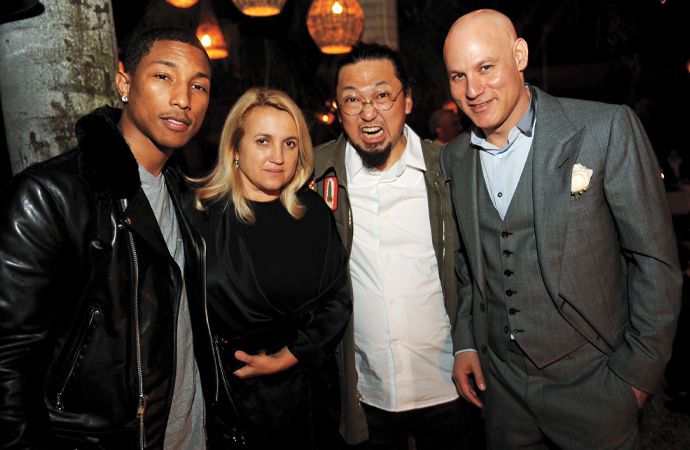
Robins with Pharrell Williams, Silvia Venturini Fendi and Takashi Murakami / Photo: Courtesy of Seth Browarnik/Worldredeye
One of the sponsors of Design Miami/ was Fendi, which led to a significant connection to its owner, the luxury conglomerate LVHM. Within a year, LVMH had become a partner in the ownership of area real estate and pledged to bring all its brands to the Design District. “We started planning for them to do global flagship stores to showcase their product through architecture, art and design,” Robins says. “And because we weren’t a mall, they could do these two- and three-story flagships on the street. We did a lot of interesting things that carried on from that, like installing Buckminster Fuller’s Fly’s Eye Dome. John Baldessari did an entire building. And after leaving MoMA as chief curator for art, architecture and design, Terry Riley curated the Museum Garage.”
Robins says his model is to emphasize culture equally with commerce.
“We wanted a neighborhood that really stands for something, a place people can enjoy. Shopping should be ancillary. There are tiered opportunities for food, for example. It’s not all Michelin-star restaurants—although in three blocks, we have more stars than in any four-mile area of Miami. People may come to take photos or go to MIA Market. Whenever you go to a place and see young people who are inspired, you feel better to be there.”
Office spaces, hotels, apartments and condominiums are also in the pipeline—but, as Robins stresses, “all on brand and in the style of the Design District.” Meanwhile, the area’s historic Moore Building, which features award-winning architect Zaha Hadid’s winding site-specific installation Elastika, will soon house an exclusive members club. “Downstairs there’ll be a public restaurant, and there will be hotel rooms and shared office spaces, as well. So though it’s a private club, there will be other ways people can interact with it.”
Sustainability has also been a key to the Design District. “We made it a priority early on,” Robins says. “We made sure to have a Tesla showroom in the neighborhood, and there are charging stations in our garages. People say, ‘Wow, this place connects with my vision.’ And those are the kind of people we want, people who care about the planet while appreciating culture.”
Today, Design Miami/has become the world’s premier venue for collecting, exhibiting and discussing design year-round, delivering unique experiences through myriad events and its digital platform, designmiami.com. In addition to its annual appearances in Miami and Basel, this month the event will make its eagerly anticipated debut in Paris, in a former residence of fashion designer Karl Lagerfeld.
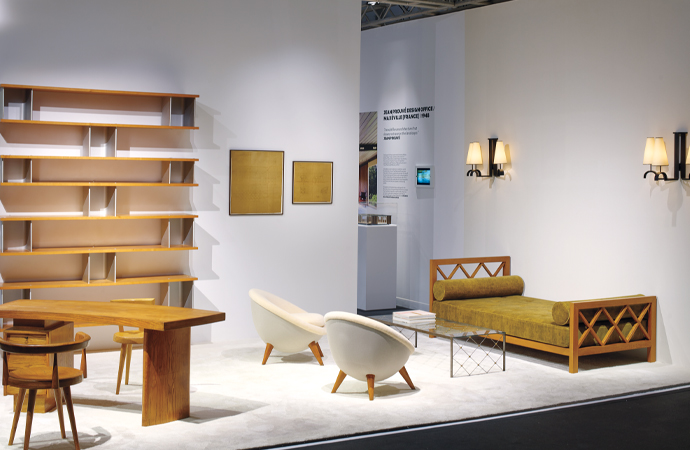
Galerie Patrick Seguin at Design Miami / Photo: Courtesy of James Harris)
“When it comes to furniture design, the most important city in the world is Paris, especially when you combine contemporary and historical elements,” Robins says. “I’m excited that Design Miami/ is now able to offer collectible design there.”
Of course, home for Robins will remain the city whose cultural landscape he helped reimagine. “South Florida has become a lot more powerful and dynamic. New York is still going to be the best city in the world, but Miami has come a long way. Miami is a city of the future—and the last few years demonstrate that. Some cities have strength because of their history, but then there are cities that are ahead of the game.”
